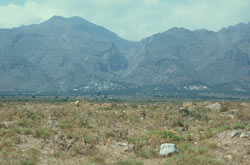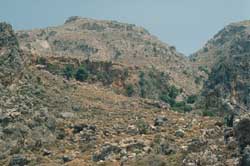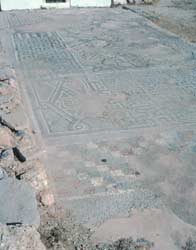An example from the Sphakia Survey
 Villages of Patsianos and Kapsodasos on the fan of erosion material which has come out of the Kallikrati Gorge (1982). © Sphakia Survey |
A brief example will show how archaeologists can use many different kinds of evidence in order to see how people lived in a particular time and place. The example is drawn from our work as part of the Sphakia Survey in SW Crete (for further information, see Unit 4 Session 2). Specifically, it relates to changes in the way people used local resources for practical and symbolic purposes in the Frangokastello area in eastern Sphakia during the Roman period (in this case first to seventh centuries AD).
Our environmental evidence suggests that climate and rainfall remained constant over this period, but that there was one major change, already mentioned - the Great Uplift of the fifth to sixth centuries when there was a change in relative sea level of + 2.8 metres.
Our documentary evidence, in the form of ancient texts, states that there was a city -state (polis) called Apollonias somewhere in this area. Other, broader historical evidence offers us background knowledge of the Roman period which we could apply to the Frangokastello area once we understood the local situation.
 Agiasmatsi Cave, looking N up at the site (centre left, marked by large carob tree). July 1990. © Sphakia Survey |
The material evidence collected and analysed by us showed clearly that in the Early Roman period, people tended to live at the northern end of the Frangokastello Plain, where the hills rise up, with one particularly large site at Patsianos Kephala. Our work also showed that at this time, people from the Frangokastello area used the nearby Agiasmatsi Cave for cult purposes.
 Ag. Nikitas mosaic in nave of Late Roman basilica, at W end of mediaeval chapel, looking E. Sept. 2000. © Sphakia Survey |
But in the later Roman period, people tended to live farther south on the plain itself, for the most part in much smaller settlements. Many of these were about 200m apart, and may have been individual farmsteads. By the end of the Late Roman period, there were two Early Christian basilicas on the plain, at Agios Astratigos and at Agios Niketas (hereafter Ag. Astratigos and Ag. Niketas).
There was thus a change in the overall settlement pattern, and in the sacred landscape as well.
As for oral information, we knew that until tourism became economically important in the later twentieth century, people had lived in two villages where the hills rise up, in other words in location similar to that of the large early Roman settlement. Local people told us that their villages were better to live in than the coast because they were cooler and there were no mosquitoes. They too had traditionally cultivated the plain, walking down to the coast to get the fresh water surfacing near the shore for irrigation. Their information made it clear that you cultivate the plain whether you lived near the hills or closer to the coast.
Our current understanding of Frangokastello is that in the early Roman period people had been living close to the mountains and away from the coast. After Crete was captured by the Romans, piracy was no longer the problem that it had been and it was safe to live within sight of the sea. In the fourth century Christianity became the official religion of the Roman Empire, and it is this distant, official change, as well as the local change in settlement pattern which explains why churches were built near the coast. The cult cave had already gone out of use when people started living near the sea and in any case it had no connection with Christian worship.
In the space of 600 years the human landscape in this small area had changed dramatically in terms of settlement and religion. What we cannot reconstruct is how people reacted to the dramatic change in sea level.